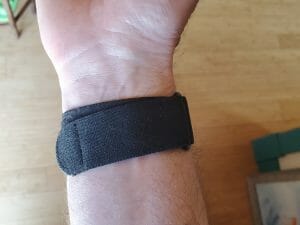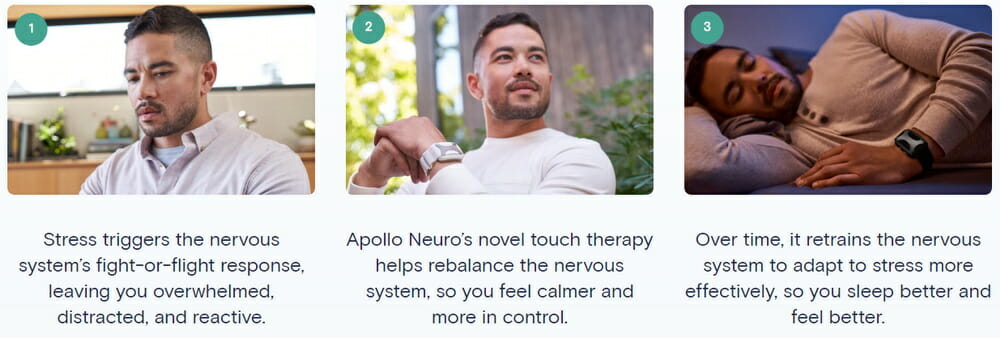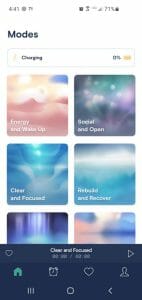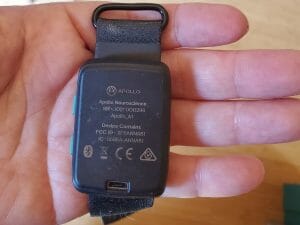Last May, I wrote that after going to a meeting on biohacking, I’d have more to say on the “tech stuff” I’ve learned about after I play with it a little. “The theory of operation,” I said, “is really interesting!” It has taken much longer to “play with it” than I had hoped before I came up with my conclusions.

Biohacking Hardware Device #1, so designated since it was the first one I bought, is the Apollo Neuro “wearable touch therapy for stress relief” band. It’s like a large, thick, wristwatch strap-on (with no display).
It “helps your body recover from stress, so you can relax, focus, sleep better, and feel better.”
The “sleep better” promise was the biggest attraction for me.
The index of articles/podcasts in this series is here. So far there is no need to go through them in any particular order.
Why Hardware?
I don’t sleep very well. It typically takes me 9-10 hours trying to sleep — not lying there reading or something — to get 7-8 hours of actual sleep. I wanted to try hardware because I didn’t want to use drugs to help me sleep.
This is the first tech device I tried that’s designed to change or reshape the wearer’s physiology.
First: I was not solicited to review the Apollo; I bought the device at retail without telling them I was going to review it online, and I will not receive any commission should you buy one (but finish this page first!)
I ordered it May 6, 2021, for “$349.00 $314.10” plus $11.99 shipping, for a total of $326.09 (“You saved $34.90” — by using a coupon code I saw that’s likely long expired now.) There is a 60-day return policy (less shipping charges). They are today still $349, and I didn’t see any special offers on their site when I looked today.
 The smartphone app’s counter shows I’ve used it on my wrist for more than 10,000 minutes now. (“We recommend using Apollo wearable at least three hours a day, five days a week, during the day and night. The more you use it, the better it works.”)
The smartphone app’s counter shows I’ve used it on my wrist for more than 10,000 minutes now. (“We recommend using Apollo wearable at least three hours a day, five days a week, during the day and night. The more you use it, the better it works.”)
Interestingly, you can also wear it on your ankle, and the company subtly indicated (read: I can’t find the suggestion now) it actually works better when you strap it there. I tried that, using the included extra-large band, and found it uncomfortable enough that it interrupted my sleep — and I woke up with a red rash under the band that took days to go away. I have not had such reactions when wearing it on my wrist, and didn’t try leg placement again.
Haptics
Apollo’s mode is physical “haptic” technology: the word haptic comes from the Greek, ἁπτικός (haptikos), which means “tactile, pertaining to the sense of touch.” It’s also known as kinaesthetic communication, or 3D touch. The Apollo does this exactly the way game controllers do: literally by using a game controller-quality vibration module, and if you’re not familiar with that, you’re probably familiar with the vibration your phone or smartwatch makes to get your attention or to signal something to you.
It was the haptics that I found interesting: it is plausible that the human nervous system would respond in sync with the physical patterns of energy that it emitted.
So how does that help with stress recovery, relaxation, focus, and sleeping and feeling better? After all, their web site says, “Apollo improves HRV [heart rate variability], Focus, Sleep, Calm, Physical Recovery” with no caveats or disclaimer other than the usual “These statements have not been evaluated by the United States Food and Drug Administration [FDA]. Individual results vary, speak to your doctor for solutions that may be appropriate for you.” in very small type in their page footer — which I didn’t find until I searched for “FDA”.

And how does the haptic module fit in to all of this? It creates vibrations of different intensities and patterns which are “automatically recognized by the body as soothing gentle touch, just like a friend giving you a hug on a bad day.” Boy, I wish. (And that’s on their “science” page!)
You can definitely feel it, but they say that it works even if the intensity is set low enough that you can’t really feel it anymore. I did experience that: sometimes I would touch it with my fingers to see if it was still on. My fingers could feel the very gentle vibrations even when my wrist couldn’t: I had tuned it out (if you will).
Modes (Programs)
There are different patterns or “modes” set up by a smartphone app that connects with the band by Bluetooth. At the moment, those modes include: “Energy and Wake Up”, “Social and Open”, “Clear and Focused”, “Rebuild and Recover”, “Meditation and Mindfulness”, “Relax and Unwind”, and “Sleep and Renew”.

Each mode has a different program of intensity, which can ramp up and down as it goes along, as well as patterns of vibration or no vibration in different sequences. You can set the intensity of each program with a slider, and choose different lengths of time the program lasts (5–60 minutes).
It’s Science!
That Science page (mentioned above) says Apollo Neuroscience was “born from research at the University of Pittsburgh,” where David Rabin, MD, PhD, and Greg Siegle, PhD, worked on the “Program in Cognitive Affective Neuroscience to develop and scientifically prove out the Apollo Neuro technology.”

“Together, they discovered that certain combinations of low frequency inaudible sound waves (vibration that you can feel, but can’t hear) can safely and reliably change how we feel through our sense of touch, and that we can measure those physiological changes in near real time.” — and that, they say, took 5 years of development and testing.
HRV really is science, is relatively new, and Apollo says they can improve it. So what is HRV?
“Heart Rate Variability (HRV) measures the rate of change of the heart beat over time. Having high HRV is a good thing. It means that your body can quickly adapt and recover from stress.
“When we encounter stress in our environment, our heart rate, respiratory rate, and blood pressure should go up so we can quickly respond to a threat. When we’re calm, our heart rate, respiratory rate, and blood pressure should be at comfortable resting rate. This is our body’s way of maintaining balance between thriving and surviving over time.” … “HRV is the most reliable, non-invasive biometric of stress, measuring the balance between the parasympathetic and sympathetic systems.” (Apollo’s science page, references omitted.)
There are plenty of studies that show that HRV over time really is an objective measure of stress, recovery, and general health.
But Does the Apollo Band Work?
They say it does, thanks to that “science,” and it may be true …for some portion of humanity. “Those who use the Apollo wearable consistently (3+ hours a day, 5+ days a week, during the day and night) see the biggest improvements in sleep and recovery metrics.”
In other words, you can’t expect to strap it on, push a button in the app, and fall right to sleep …dang it.
As noted above, I’ve used the Apollo band for over 10,000 minutes now. In the 300ish days since receiving it, that’s only around 33 minutes/day, but I have gone many weeks using it much more, and many more weeks not using it at all, especially when I was testing Hardware Device #2, to get a comparison as to how I felt with and without the Apollo over time, including weeks where I definitely used it “3+ hours a day, 5+ days a week, during the day and night.”
(I did not use it at the same time as the second device, to be discussed later.)
And my personal conclusion?
I don’t notice any difference whatever from the “Relax and Unwind” or “Sleep and Renew” modes despite having an objective measure of my sleep quality …which will be discussed in Biohacking Hardware 3. (Part 2 is coming first, of course.)
As for other modes detailed above, I tried them all — and noticed no enhanced energy or start-the-day wakeup clarity, I was no more social or open (or antisocial or closed) than usual, I didn’t find any extra clarity or focus, it didn’t help with my meditation or mindfulness (I do meditate), nor noticed any enhancement of my everyday physical or mental rebuilding/recovery.
In short, a complete dud, at least for me.
Maybe you will get much better results from the Apollo. Or maybe it’s modern hokum. I can’t say for sure, but I definitely can’t give it my personal recommendation. Damn it.
Sidebar: Physical Review
The Apollo Neuro comes with the “watch” module (black was the only color available when I bought), two fabric bands (wrist and ankle), and a USB cable to charge from your standard USB charger or computer.

The first thing I noticed: the USB port is on the inside of the “watch,” which means you’re forced to take it off to charge it [insert eyeroll here]. That also means it’s less vulnerable to dust (hardly seems a likely problem: you put your phone in a pocket, which has lots of dust, probably without a problem with its USB charge port!), but does subject the port to more moisture and skin oils, so I consider that placement less than desirable.
The second thing I noticed: despite the date purchased, it uses the obsolete micro USB connector, not USB-C [eyeroll #2 here]. I mounted it so it was in contact with my inner wrist; their instructions show it in contact with both inside and outside wrists, so it apparently doesn’t matter: use what’s comfortable.
It’s clunky and ugly, but seems to work as designed. At least no one ever asked “What’s that fugly thing on your wrist?”, which is a plus. Not high praise, but there you go.
IF you choose to buy one, at least try using a Google search to find a coupon, and note they now come in several colors other than black.
– – –
Bad link? Broken image? Other problem on this page? Use the Help button lower right, and thanks.
This page is an example of my style of “Thought-Provoking Entertainment”. This is True is an email newsletter that uses “weird news” as a vehicle to explore the human condition in an entertaining way. If that sounds good, click here to open a subscribe form.
To really support This is True, you’re invited to sign up for a subscription to the much-expanded “Premium” edition:
Q: Why would I want to pay more than the minimum rate?
A: To support the publication to help it thrive and stay online: this kind of support means less future need for price increases (and smaller increases when they do happen), which enables more people to upgrade. This option was requested by existing Premium subscribers.

Given that glowing review you gave the device (and my long delay in reading this), I wonder if you had any takers on purchasing your slightly used model?
—
Not yet — I’ll remove that reference once it’s sold. It is not at all surprising that it’s not going quickly per my review, but perhaps someone wants to try it after reading this, and (I hope) some of their research. -rc
I am looking forward to your future articles on Biohacking having just watched an episode of “The Good Doctor” which included that topic in its plot. Thanks for being so thorough in the topics you write about.
—
More coming soon! -rc